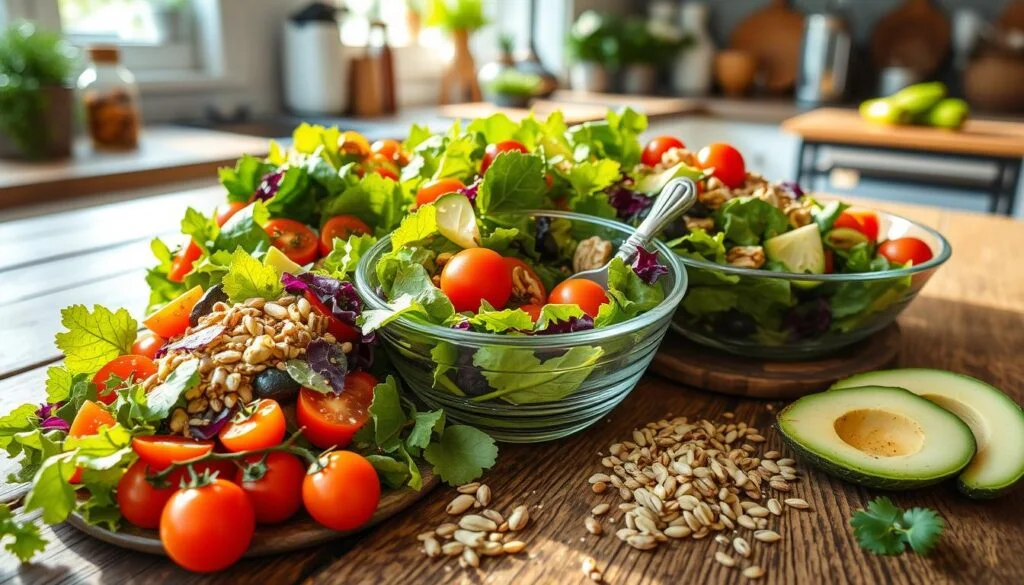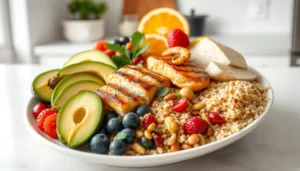The Simple Hacks You Need to Eat More Salads
The Simple Hacks You Need to Eat More Salads
Salads are known for being healthy and nutritious. But, many struggle to make them a part of their daily meals. It might be because of a lack of ideas, not enough time, or not liking some veggies. Yet, with the right tricks and a bit of creativity, anyone can start eating more salads.

Key Takeaways
- Salads are full of vitamins, minerals, and fiber, making them key to a healthy diet.
- Eating more salads can help with weight, improve digestion, and boost health.
- Meal prep and the right tools can make salad making fast and easy, overcoming common hurdles.
- Trying new ingredients and homemade dressings can make salads tasty and fulfilling.
- Simple tips and hacks can help you make salads a regular part of your day.
Why Making Salads a Daily Habit Transforms Your Health
Adding salads to your daily meals can greatly improve your health. Raw veggies are packed with vitamins, minerals, and antioxidants. They offer more than just weight loss benefits.
Understanding the Nutritional Power of Raw Vegetables
Raw veggies are full of important vitamins, minerals, and antioxidants. These nutrient-dense foods are high in fiber, which is good for digestion and metabolism. Eating a variety of raw veggies boosts your immune system and lowers disease risk.
The Role of Salads in Weight Management
Salads are great for managing weight. They’re full of fiber that keeps you feeling full. This can help you eat less and lose weight slowly but surely.
Health Benefits Beyond Weight Loss
Salads do more than help with weight. They can lower your risk of heart disease, type 2 diabetes, and some cancers. The antioxidants in them protect your cells and may slow aging.
| Nutrient | Benefits |
|---|---|
| Fiber | Aids digestion, regulates metabolism, promotes feelings of fullness |
| Vitamins and Minerals | Support immune function, cellular health, and various bodily processes |
| Antioxidants | Protect cells from oxidative stress, reduce inflammation, and may slow aging |
“Salads are a delicious and convenient way to incorporate a wealth of essential nutrients into your daily diet, transforming your health from the inside out.”
Essential Tools and Equipment for Quick Salad Preparation
Making delicious salads doesn’t have to take a lot of time. The right kitchen tools make it easy and fun. You’ll need things like salad spinners and mandoline slicers to get the job done fast.
A sharp chef’s knife and a serrated bread knife are key. They help you chop and slice ingredients quickly. Use a sturdy cutting board for safety and comfort.
A food processor speeds up vegetable prep. It can shred, grate, and slice ingredients fast. A salad spinner also helps by removing moisture from greens, keeping them fresh.
Good storage containers keep your salad ingredients fresh. Choose high-quality, airtight containers. With the right tools, making healthy salads is easy.
| Tool | Purpose |
|---|---|
| Chef’s Knife | Chopping and dicing vegetables |
| Serrated Bread Knife | Slicing tomatoes, cucumbers, and other soft ingredients |
| Cutting Board | Providing a stable surface for cutting and dicing |
| Food Processor | Shredding, grating, and slicing vegetables quickly |
| Salad Spinner | Removing excess moisture from greens and other salad components |
| Storage Containers | Keeping salad ingredients fresh and organized for meal prep |
With these tools, making salads is quick and easy. Enjoy fresh, healthy salads with less effort.
The Art of Meal Prepping Your Salad Ingredients
Meal prepping your salad ingredients is a big help for a healthy diet. It saves time and makes sure you always have fresh ingredients ready. This makes it easy to make healthy salads whenever you want.
Storage Solutions for Fresh Ingredients
Keeping your salad ingredients fresh is key. Use airtight containers, resealable bags, and glass jars. This helps your greens, veggies, and toppings stay fresh longer. Make sure to wash and dry your produce well before storing.
Batch Preparing Components
- Chop and slice veggies like bell peppers, cucumbers, carrots, and tomatoes ahead of time.
- Cook proteins like grilled chicken, hard-boiled eggs, or roasted chickpeas and keep them in the fridge for easy use.
- Make salad dressings and store them in small jars or containers for quick access.
Time-Saving Chopping Techniques
Here are some ways to chop faster and more efficiently:
- Use a sharp chef’s knife or mandoline slicer for even, thin cuts.
- Get a good food processor or chopper to quickly shred, dice, or mince ingredients.
- Chop several ingredients at once to save time.
| Meal Prep Tip | Benefits |
|---|---|
| Storing washed and dried greens in a salad spinner | Helps maintain crispness and prevents wilting |
| Portioning out individual salad components in containers | Makes it easy to grab and go for a quick, balanced meal |
| Preparing large batches of dressings and dips | Saves time and ensures you always have flavorful toppings on hand |
“Meal prepping your salad ingredients is a game-changer when it comes to maintaining a healthy eating routine.”
The Simple Hacks You Need to Eat More Salads
Eating more salads can greatly improve your health. But, preparing them might seem daunting. Luckily, there are simple tricks to make salads a part of your daily life.
One easy way to eat more veggies is to make salads the main part of your meals. Instead of just a side, turn your lunch or dinner into a big salad. Add greens, proteins, and healthy fats to boost your nutrition and help with weight management.
Another great salad hack is to prep your salad ingredients ahead of time. Chop extra veggies, cook proteins like chicken or chickpeas, and have toppings and dressings ready. This way, you can whip up a healthy, tasty salad anytime.
- Make salads the main event, not just a side dish
- Meal prep salad ingredients for easy assembly
- Keep a variety of flavorful dressings on hand
- Experiment with different vegetable combinations and textures
- Incorporate leftovers from other meals into your salads
By using these simple salad hacks, you can change your eating habits. Enjoy the health benefits of adding more vegetables to your diet.

“The key to eating more salads is to make them appealing and convenient. With a little preparation, you can turn a simple salad into a satisfying, nutrient-dense meal.”
Building a Perfect Salad Formula: Mix and Match Guide
Making a tasty and healthy salad is like an art. You just need a few simple rules. Knowing what makes a salad good lets you try new flavors and make meals that are good for you.
Choosing Your Greens Base
The base of any salad is the greens. Choose from spinach, kale, romaine, or arugula for a healthy start. Each green has its own taste and texture, so you can make your salad just how you like it.
Adding Proteins and Healthy Fats
To make your salad a full meal, add good protein and fats. Use lean meats, grilled chicken, hard-boiled eggs, or plant-based options like chickpeas or tofu for protein. Avocado, nuts, seeds, and olive oil add healthy fats that make your salad balanced.
Incorporating Texture and Crunch
Adding different textures makes your salad look good and fun to eat. Try adding nuts, seeds, or croutons for crunch. Also, crisp veggies like carrots, bell peppers, or cucumber add a nice contrast to the greens.
| Salad Component | Options |
|---|---|
| Greens | Spinach, kale, romaine, arugula, mixed greens |
| Proteins | Grilled chicken, hard-boiled eggs, roasted chickpeas, tofu |
| Healthy Fats | Avocado, nuts, seeds, olive oil |
| Texture and Crunch | Toasted nuts, seeds, croutons, carrots, bell peppers, cucumber |
By mixing these key parts, you can make a salad that’s both tasty and healthy. Try different mixes to find your favorite salad recipe.
Mastering Homemade Salad Dressings
Improving your salad game begins with homemade salad dressings. Ditch the store-bought stuff full of preservatives and too much salt. Making your own lets you choose the flavors and ingredients. This way, you get healthier and tastier salads.
Looking for a tangy vinaigrette, creamy ranch, or zesty citrus dressing? The options for salad dressing recipes are endless. By trying different flavor combinations, you can find the perfect match for your salad.
The Benefits of Homemade Dressings
Making your own healthy dressings means avoiding bad additives. It also lets you get creative. You can adjust flavors to your liking, try oil-free options, and add nutritious ingredients like avocado or tahini.
- Complete control over the ingredients and flavors
- Ability to create oil-free options and healthier alternatives
- Opportunity to explore a variety of flavor combinations
- Savings compared to store-bought dressings
Learning to make your own salad dressings changes your salad game. With a bit of creativity and trying new things, your salads will become a flavorful highlight of your healthy diet.
“The secret to a great salad is in the dressing. Homemade dressings can take your salad from ordinary to extraordinary.”
Creative Ways to Make Your Salads More Exciting
Salads are a great way to eat healthy and add variety to your meals. But, they can get boring if you stick to the same old recipes. It’s time to try new flavors and use fresh, seasonal ingredients.
Global Flavor Inspirations
Explore beyond traditional salads and discover new tastes. Add international flavors to your salads for a twist. Think about the bold spices of Indian curries or the zesty citrus of Mexican dishes.
- Try a Mediterranean-inspired salad with crisp greens, chickpeas, feta, and a tangy lemon-garlic dressing.
- Embrace the flavors of Asia with a Thai-style salad featuring shredded cabbage, grilled chicken, crushed peanuts, and a vibrant Thai chili-lime dressing.
- Experiment with Middle Eastern flavors by tossing together a salad of mixed greens, roasted beets, crumbled feta, and a creamy tahini-based dressing.
Seasonal Ingredient Combinations
Salads are a great way to enjoy the best of what’s in season. Use fresh, seasonal ingredients to make your salads exciting all year round.
| Season | Seasonal Produce | Flavor Pairings |
|---|---|---|
| Spring | Asparagus, peas, radishes, strawberries | Lemon, mint, feta, toasted almonds |
| Summer | Tomatoes, cucumbers, corn, peaches | Basil, avocado, balsamic vinegar, grilled chicken |
| Fall | Kale, Brussels sprouts, apples, pears | Roasted squash, pecans, maple vinaigrette |
| Winter | Citrus fruits, beets, Brussels sprouts, pomegranate | Goat cheese, candied walnuts, citrus vinaigrette |
By trying new flavors and using seasonal ingredients, you can make your salads more exciting. They’ll be more flavorful and satisfying than ever.
Smart Solutions for On-the-Go Salad Eating
Enjoying a fresh salad doesn’t have to be just for home. With the right tools, you can enjoy portable salads anywhere. This includes the office or during your commute.
Investing in meal prep containers is a smart move. These containers keep your salad ingredients fresh and separate. Salad jars are also great, letting you layer your salad for a perfect workplace lunch.
| Container Type | Key Benefits |
|---|---|
| Meal Prep Containers | Keeps ingredients fresh and separated |
| Salad Jars | Layered design prevents soggy greens |
For extra flavor, pack a small dressing or dip. Also, carry compact utensils in your bag. This way, you can make a healthy meal anytime, anywhere.
“The key to eating more salads on the go is having the right portable containers and a little advance preparation.”
Using these smart solutions makes it easy to enjoy portable salads in your busy life. Whether you’re commuting, traveling, or at the office for long hours, salads can be part of your day.

Common Salad Mistakes and How to Avoid Them
Making the perfect salad needs careful attention. Stay away from common mistakes that can hurt food safety, salad freshness, and the fun of ingredient preparation and salad longevity. Learning a few easy tricks can make your salads better and more enjoyable.
Proper Washing and Drying Techniques
It’s key to wash and dry greens and veggies well for food safety and salad freshness. Rinse all produce under cold water to get rid of dirt and harmful stuff. Then, dry them with paper towels or a salad spinner to remove moisture before making your salad.
Timing and Assembly Tips
Timing is crucial for salad longevity. Make your salad just before eating to keep greens crisp. If you’re preparing ahead, keep dressing and crunchy toppings separate until serving. Put denser items like proteins and veggies at the bottom and greens on top to keep them fresh.
| Common Salad Mistakes | Solution |
|---|---|
| Inadequate washing and drying | Thoroughly rinse and completely dry greens and vegetables |
| Premature salad assembly | Assemble salad just before serving, storing dressing and toppings separately |
| Improper storage of ingredients | Store prepped components in the fridge to maintain freshness |
By avoiding these common errors and using these simple tips, you’ll get food safety, salad freshness, great ingredient preparation, and longer-lasting salad longevity with every delicious bite.
Conclusion
Adding more salads to your daily life can greatly improve your healthy lifestyle. It boosts your nutrition goals with fresh veggies. It also helps with dietary changes for weight control.
This article has given you great tips for making salads easy. You learned how to make your own dressings and mix flavors. Now, you can turn salads into a fun, healthy part of your day.
Keep up the good work and enjoy the salad benefits. By eating salads every day, you’ll see big improvements in your health. Enjoy the tastes, textures, and feel the good effects on your body and mind. Here’s to a healthier, happier you!
FAQ
What are the key health benefits of making salads a daily habit?
Regularly eating salads can greatly improve your health. They help with digestion, boost nutrient intake, aid in weight management, and prevent diseases. Salads are packed with fiber, antioxidants, and vitamins that are good for you.
What are the essential tools and equipment for quick salad preparation?
For fast salad prep, you need certain tools. These include good knives, cutting boards, a salad spinner, mandoline slicer, and food processor. These tools make chopping and storing salad ingredients easier.
How can I meal prep my salad ingredients to save time?
Meal prepping salad ingredients saves time. It involves storing fresh produce, preparing batches of chopped veggies and hard-boiled eggs, and using quick chopping methods. This way, you have salad ingredients ready all week.
What are some simple hacks to eat more salads?
To eat more salads, make them more appealing. Try new ingredients and flavors. Also, add salads to different meals and find ways to eat more veggies.
How can I create a balanced and satisfying salad?
To make a great salad, start with a good base of greens. Add proteins and healthy fats. Mix in different textures and crunch. This balance makes your salad filling and healthy.
What are some tips for making homemade salad dressings?
Homemade salad dressings let you control what goes in them. Balance the acidity, use quality oils, and try new flavors. You can also find healthier dressing options.
How can I make my salads more exciting and varied?
To spice up your salads, try global flavors and use seasonal produce. Experiment with new ingredients and cooking methods. This keeps your salads fresh and exciting.
What are some smart solutions for eating salads on the go?
For salads on the move, use portable containers or salad jars. Find ways to make fresh salads at work or while traveling. This way, you can enjoy healthy salads anywhere.
What are some common salad mistakes to avoid?
Avoid common salad mistakes like soggy greens from bad washing and drying. Also, watch out for timing and assembly issues that affect freshness. Always follow food safety rules.






Post Comment